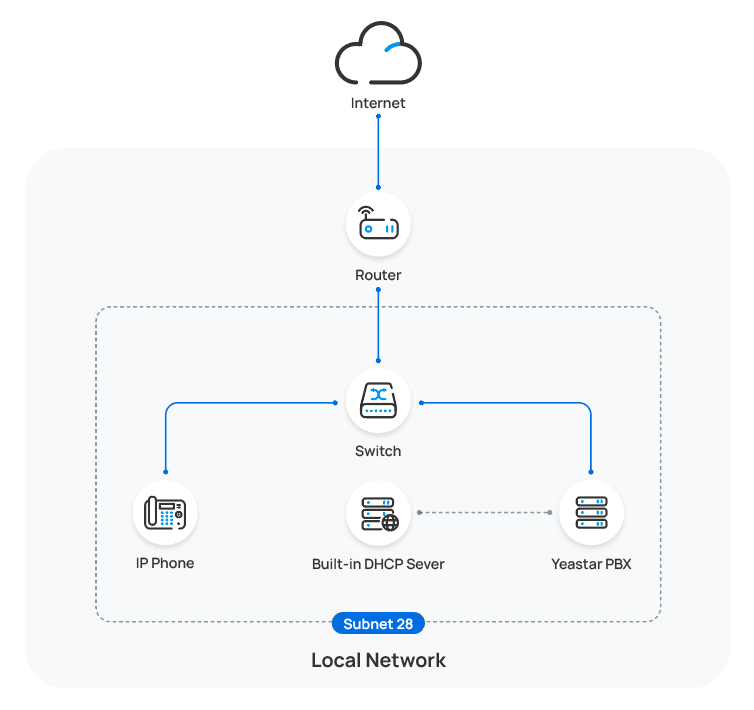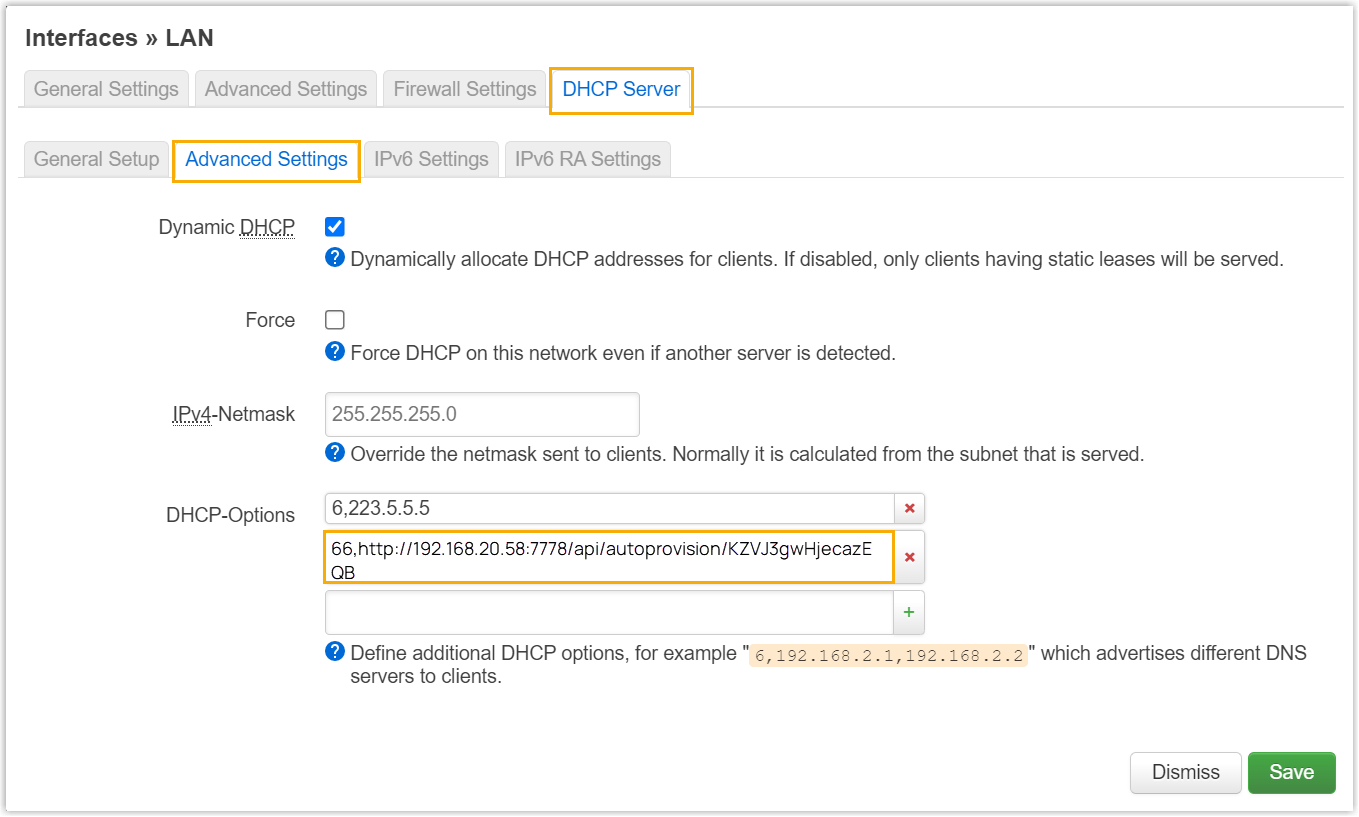Auto Provision Wildix IP Phone with Yeastar P-Series Software Edition
This topic takes Wildix WP480R3 (firmware: 63.145.10.168) as an example to describe how to auto provision Wildix IP phones with Yeastar P-Series Software Edition.
Requirements
The firmwares of Wildix IP phone and Yeastar PBX meet the following requirements.
| Model | Phone Requirement | PBX Requirement | Supported Auto Provisioning Method |
|---|---|---|---|
| WP410R2 | 50.145.6.169 or later |
83.15.0.22 or later |
|
| WP480R2 | 55.145.6.111 or later |
83.15.0.22 or later |
|
| WP480R3 | 63.145.10.168 or later |
83.15.0.22 or later |
|
| WP480R4 | 65.145.6.38 or later |
83.15.0.22 or later |
|
| WP490R2 | 59.145.6.148 or later |
83.15.0.22 or later |
|
| WP490R3 | 67.145.8.107 or later |
83.15.0.22 or later |
|
Scenarios
Yeastar P-Series Software Edition supports to auto provision Wildix IP phone via DHCP method in the local network. The provisioning operations vary depending on the network environment of Wildix IP phone and Yeastar PBX, as the following table shows.
| Scenario | Description |
|---|---|
| IP Phone and PBX are in the SAME subnet | In this scenario, you can provision the Wildix IP phone using
the PBX built-in DHCP server to deliver a PBX-provided
provisioning link to the IP phone. In this way, the phone can
retrieve configurations from the PBX using the given link. Note: If there is already a DHCP
server running in the subnet, you can directly set up DHCP option 66 with
PBX-provided provisioning link on the
DHCP server.
For more information, see Auto provision a Wildix IP phone in the same subnet. |
| IP Phone and PBX are in DIFFERENT subnets | In this scenario, you can provision the Wildix IP phone using
DHCP option 66 of a third-party DHCP server to deliver a
PBX-provided provisioning link to the IP phone. In this way, the
phone can retrieve configurations from the PBX using the given
link. For more information, see Auto provision a Wildix IP phone in different subnets. |
Auto provision a Wildix IP phone in the same subnet
In this example, the Wildix IP phone and the Yeastar PBX (IP:
192.168.28.39) are both deployed in subnet 28.

- Prerequisites
-
- Make sure that there is only one DHCP server running in the subnet, or the IP phone would fail to obtain an IP address.
- Make sure that you have downloaded the template for the desired phone model (Path: ).
- RESET the IP phone if it is previously used.
- Gather information of IP phone, including Vendor, Model, and MAC address.
- Procedure
- Step 1. Set the PBX as a DHCP server
-
- Log in to PBX web portal, go to , click DHCP Server tab.
- Turn on the DHCP Server, and complete the
following network configurations.

- Gateway: Specify the IP address of the default gateway for the DHCP server.
- Subnet Mask: Specify the subnet mask used to subdivide your IP address.
- Preferred DNS Server: Specify a DNS server for the DHCP server.
- Alternative DNS Server: Optional. Specify a secondary DNS server for the DHCP server.
- DHCP Address Range: Specify the IP address range that will be allocated to DHCP clients.
- NTP Server: Enter the IP
address of an NTP server.Note: The default value is the IP address of the PBX, which can synchronize the network time of the client devices with the PBX.
- Click Save.
The Status field displays Running, indicating the DHCP server is running.

- Step 2. Add the Wildix IP phone on PBX
-
- On PBX web portal, go to .
- Click .
- In the IP Phone section,
enter the following phone information.

- Vendor: Select Wildix.
- Model: Select the phone model. In this example, select WP480R3.
- MAC Address: Enter the MAC address of the IP phone.
- In the Options section, configure the
following settings.

- Template: Select a desired template
from the drop-down list.Note: You can select the default template corresponding to the phone model, or customize your own template. For more information, see Create a Custom Auto Provisioning Template.
- Provisioning Method: Select
DHCP (In the Office).
A provisioning link is automatically generated and displayed in the Provisioning Link field. This provisioning link points to the location where the phone's configuration file is stored.
- Template: Select a desired template
from the drop-down list.
- In the Assign Extension
section, assign an extension to the IP phone.
 Note: If your desired extension is not listed in the drop-down list, it indicates that the extension has been associated with an IP phone or gateway.
Note: If your desired extension is not listed in the drop-down list, it indicates that the extension has been associated with an IP phone or gateway.- To release the extension from the associated IP phone or gateway, see Release an Extension from a Provisioned IP Phone/Gateway.
- To assign the extension to the phone without releasing it from the previously associated device, you can configure the concurrent registration setting for the extension, as the PBX only allows an extension to register with one SIP endpoint by default.
- Click Save.
- Result
-
Note: Some IP phones will reboot automatically. If not, you need to manually reboot the phone to make the configurations take effect.
Auto provision a Wildix IP phone in different subnets
In this example, the Wildix IP phone and a DHCP server are deployed in subnet 28,
while the Yeastar PBX (IP: 192.168.20.58) is deployed in subnet
20.

- Prerequisites
-
- Make sure that there is only one DHCP server running in the subnet where the IP phone is deployed, or the IP phone would fail to obtain an IP address.
- Make sure that the IP phone and PBX can communicate with each other over the subnets.
- Make sure that you have downloaded the template for the desired phone model (Path: ).
- RESET the IP phone if it is previously used.
- Gather information of IP phone, including Vendor, Model, and MAC address.
- Procedure
- Step 1. Enable Remote Registration feature for the extension on PBX
- Enable the Remote Registration feature for the extension to be assigned to the phone, so that the extension can be registered in a different subnet.
- Step 2. Add the Wildix IP phone on PBX
-
Add the IP phone on PBX. The PBX will generate a configuration file based on the phone's MAC address.
- Step 3. Configure DHCP option 66 on DHCP server
-
In the subnet where the IP phone is deployed, use the generated provisioning link to configure option 66 on the DHCP Server.
- On PBX web portal, copy the provisioning link
from the phone's detail page.

- On the DHCP server, set up option 66 with the provisioning
link.
In this example, the configuration is shown below.

- On PBX web portal, copy the provisioning link
from the phone's detail page.
- Result
-
- After the IP phone is rebooted, it gets an IP address from the DHCP server, downloads the configurations from the PBX via the provisioning link, and applies the settings automatically.
- The extension is successfully registered on the
IP phone. You can check the extension registration status on on the PBX web portal.


